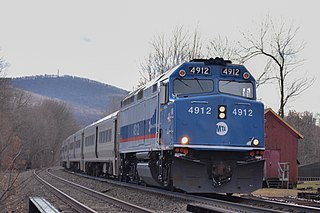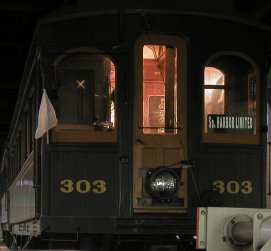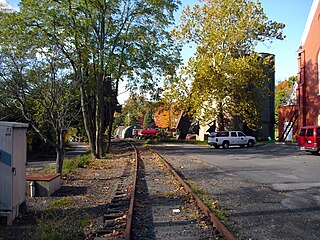
The Delaware, Lackawanna and Western Railroad, also known as the DL&W or Lackawanna Railroad, was a U.S. Class 1 railroad that connected Buffalo, New York, and Hoboken, New Jersey, and by ferry with New York City, a distance of 395 miles (636 km). The railroad was incorporated in Pennsylvania in 1853, and created primarily to provide a means of transport of anthracite coal from the Coal Region in Northeast Pennsylvania to large coal markets in New York City. The railroad gradually expanded both east and west, and eventually linked Buffalo with New York City.

The Moodna Viaduct is a steel railroad trestle spanning Moodna Creek and its valley at the north end of Schunemunk Mountain in Cornwall, New York, near the hamlet of Salisbury Mills.

The Bergen County Line is a commuter rail line and service owned and operated by New Jersey Transit in the U.S. state of New Jersey. The line loops off the Main Line between the Meadowlands and Glen Rock, with trains continuing in either direction along the Main Line. It is colored on NJT system maps in grey, and its symbol is a cattail, which are commonly found in the Meadowlands where the line runs.

The Northern Branch is a railroad line that runs from Jersey City to Northvale in northeastern New Jersey, and formerly extended further into New York State. The line was constructed in 1859 by the Northern Railroad of New Jersey to connect the New York and Erie Railroad's Piermont Branch terminus in Piermont, New York, directly to Erie's primary terminal in Jersey City, initially Exchange Place, later Pavonia Terminal. In 1870 the line was extended to Nyack, New York, and continued to provide passenger service until 1966. After the Erie's unsuccessful merger with the Lackawanna Railroad to form the Erie-Lackawanna, ownership of the line passed into the hands of Conrail upon its formation in 1976 from a number of bankrupt railroads.
The Pittsburgh and Lake Erie Railroad, also known as the "Little Giant", was formed on May 11, 1875. Company headquarters were located in Pittsburgh, Pennsylvania. The line connected Pittsburgh in the east with Youngstown, Ohio, in the Haselton neighborhood in the west and Connellsville, Pennsylvania, to the east. It did not reach Lake Erie until the formation of Conrail in 1976. The P&LE was known as the "Little Giant" since the tonnage that it moved was out of proportion to its route mileage. While it operated around one tenth of one percent of the nation's railroad miles, it hauled around one percent of its tonnage. This was largely because the P&LE served the steel mills of the greater Pittsburgh area, which consumed and shipped vast amounts of materials. It was a specialized railroad, deriving much of its revenue from coal, coke, iron ore, limestone, and steel. The eventual closure of the steel mills led to the end of the P&LE as an independent line in 1992.

The Lehigh and Hudson River Railway (L&HR) was the smallest of the six railroads that were merged into Conrail in 1976. It was a bridge line running northeast–southwest across northwestern New Jersey, connecting the line to the Poughkeepsie Bridge at Maybrook, New York, with Easton, Pennsylvania, where it interchanged with various other companies.

The Port Jervis Line is a predominantly single-track commuter rail line running between Suffern and Port Jervis, in the U.S. state of New York. At Suffern, the line continues south into New Jersey on NJ Transit's Main Line. The line is operated by NJ Transit Rail Operations under a contract with Metro-North Railroad (MNRR).

New York State Route 94 (NY 94) is a state highway entirely within Orange County in southern New York. The western terminus is at the New York–New Jersey state line, where it continues as New Jersey's Route 94 for another 46 miles (74 km) to Columbia, New Jersey. Its eastern terminus is located at U.S. Route 9W (US 9W) in New Windsor. From Warwick to Florida, NY 94 is concurrent with NY 17A. The entirety of NY 94 is known as the 94th Infantry Division Memorial Highway.

Salisbury Mills–Cornwall station is a commuter rail stop owned by Metro-North Railroad serving trains on the Port Jervis Line, located in the Beaver Dam Lake section of the town of Cornwall, New York. The station is located at the northern end of the Moodna Viaduct, accessible from NY 94.

Cleveland has been and continues to be deeply rooted in railroad history.

Kingsland is a railroad station on New Jersey Transit's Main Line. It is located under Ridge Road (Route 17) between New York and Valley Brook Avenues in Lyndhurst, New Jersey, and is one of two stations in Lyndhurst. The station is not staffed, and passengers use ticket vending machines (TVMs) located at street level to purchase tickets. The station is not handicapped-accessible. Originally part of the Delaware, Lackawanna and Western Railroad's Boonton Branch, the current Kingsland station was built in 1918.

Paterson is a New Jersey Transit commuter railway station located on an elevated viaduct above Market Street in downtown Paterson, New Jersey. The railway through the station is double tracked, for north and south traffic on the NJT Main Line.

Moodna Creek is a small tributary of the Hudson River that drains eastern Orange County, New York. At 15.5 miles (25 km) in length from its source at the confluence of Cromline Creek and Otter Kill west of Washingtonville, it is the longest stream located entirely within the county.

The Metro-North Railroad's Beacon Line is a non-revenue line connecting the railroad's three revenue lines east of the Hudson River. From west to east, the lines that connect are Hudson Line, Harlem Line, and the Danbury Branch of the New Haven Line. It was purchased by Metro-North in 1995 for $4.2 million from Maybrook Properties, a subsidiary of the Housatonic Railroad, to preserve it for future use, training, and equipment moves. Maybrook Properties purchased the line from Conrail after Conrail withdrew from the Danbury, Connecticut, freight market in 1992.

The Orange Heritage Trailway is a 19.5-mile (31.4 km) rail trail in Orange County, New York, that runs along the roadbed of the Erie Railroad's Main Line from Harriman, NY to nearby Middletown.

The Bushwick Branch, also called the Bushwick Lead Track, is a freight railroad branch in New York City. It runs from the East Williamsburg neighborhood of Brooklyn to Fresh Pond Junction in the Glendale neighborhood of Queens, where it connects with the Montauk Branch of the Long Island Rail Road. It is owned by the LIRR but operated under lease by the New York and Atlantic Railway, which took over LIRR freight operations in May 1997.
Central Railroad of Long Island was built on Long Island, New York, by Alexander Turney Stewart, who was also the founder of Garden City. The railroad was established in 1871, then merged with the Flushing and North Side Railroad in 1874 to form the Flushing, North Shore and Central Railroad. It was finally acquired by the Long Island Rail Road in 1876 and divided into separate branches. Despite its short existence, the CRRLI had a major impact on railroading and development on Long Island.

Morristown & Erie Railway is a short-line railroad based in Morristown, New Jersey, chartered in 1895 as the Whippany River Railroad. It operates freight rail service in Morris County, New Jersey and surrounding areas on the original Whippany Line between Morristown and Roseland, as well as the Morris County-owned Dover & Rockaway Branch, Chester Branch, and High Bridge Branch. The M&E also operated the Maine Eastern Railroad from November 2003 to December 31, 2015.

The Graham Line is the portion of the former Erie Railroad in New York State from Highland Mills to Guymard, constructed from 1906 to 1909 as a high-speed freight line. The Graham Line bypasses the original Erie Main Line through Monroe, Chester, Goshen and Middletown.
The Valley Railway was a shortline railroad which operated between the city of Cleveland and small town of Zoarville in the state of Ohio in the United States. The railroad was founded in 1871, but the first segment of track did not open until 1880 and the line was not completed until 1884. The Baltimore and Ohio Railroad (B&O) obtained a controlling interest in the Valley Railway in 1890. The railroad went bankrupt in 1895, at which time it was reorganized as The Cleveland Terminal and Valley Railroad Company (CT&V). The B&O took over operation of the CT&V in 1909, and the company was merged with the B&O in 1915.

















